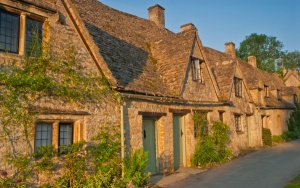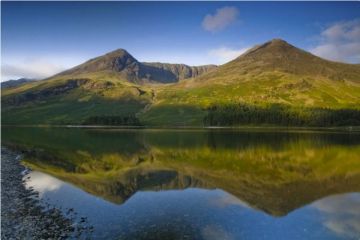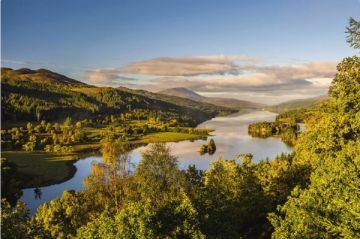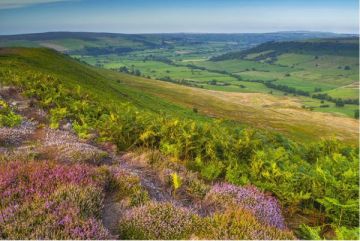< BACK | VIRTUAL TOUR | NEXT >

The name "Cotswolds" is rightly applied to a high escarpment running north from the outskirts of Bath and petering out somewhere near the borders of Worcestershire. Along that ridge, and in the valleys that radiate out from it, lie some of the prettiest, most "English" villages in the entire country. Although some, like Broadway, are well-known and frequented by tour buses, others slumber on. Among the latter are Lower Slaughter, and Bibury, where the ivy-clad Swan Inn provides a relaxing break from exploring the medieval cottages and delightful church.
At pretty Bourton-on-the-Water, the River Windrush meanders through the centre of the village, and is crossed by stone bridges so low you can trail a foot in the water. The cottages are built of lovely golden "Cotswold stone", a warm-toned limestone that gives the villages of this region a charm found in few other places.
The Cotswold area is famed for its "wool churches", large and highly decorated parish churches built with the proceeds of the profitable wool trade during the late medieval period. Large parish churches like that at Northleach look as though they should belong to a busy, prosperous town instead of a sleepy little village.

At Stow-on-the-Wold rose-covered antique shops surround a village green with its medieval stocks still in place. The village church is entered through a door framed by the branches of an ancient tree. The town's exposed position on a high hilltop is emphasized by a famous rhyme; "Stow-on-the-Wold, where the wind blows cold". Just north of the town are the Rollright Stones, an unpretentious prehistoric stone circle.
Bath is one of the tourist magnets of Britain, and rightfully so. It is less crowded than London, and its attractions are concentrated in an area easily walked in a day of sightseeing. Bath Abbey is one of the last major churches built in England before the Dissolution of the Monasteries, and it contains some wonderful fan vaulting.
At the Roman Baths museum, you can see the hot springs and baths that gave this city its name. Above the baths are the Georgian Pump Rooms, familiar to readers of Regency romances the world over. Here you can drink a glass of the waters that drew health-seekers and fashionable society in Georgian and Regency times.

Near Bath is Bradford-upon-Avon, where the largely unaltered Saxon church of St Lawrence provides a rare glimpse of Dark Ages worship. At pretty Lacock the entire village is preserved by the National Trust, and at Lacock Abbey you can see mementoes of William Fox-Talbot, who helped pioneer photography from this former medieval nunnery. The village also houses a Museum of Photography, with many rare cameras. Lacock featured in the film version of Jane Austen's Pride and Prejudice.
Cheltenham preserves a different era in English history - the town owes its prosperity - and much of its fine architecture - to the spa which became enormously popular here in the Georgian period. The town is resplendent in Regency terraces of cream-white houses and wrought-iron railings. The Promenade is the heart of Regency Cheltenham, a refined main street filled with beautiful architecture. In the summer months, baskets of flowers are hung from the buildings that verge on The Promenade.

Far from the elegance of the Regency are the prehistoric remains clustered around the small village of Avebury. Part of the village is built within the bounds of the stone circle which bears the village's name. Unlike Stonehenge, visitors can wander through the circle - and dodge sheep who are doing the same! Nearby is West Kennet Long Barrow, one of the best-preserved burial mounds in England, and across the busy A4 road is the mysterious cone of Silbury Hill, in volume the largest man-made structure in Europe.
At Bristol the city's proud history as a port is preserved in the dry-docked SS Great Britain, at one time the largest vessel in the world, and the Maritime Heritage Centre, with displays on the history of shipbuilding. At Gloucester a different kind of waterborne heritage is celebrated at the National Waterways Museum. Visitors can explore the colourful history of England's traditional canal boats, and go for a ride in a "narrowboat".











